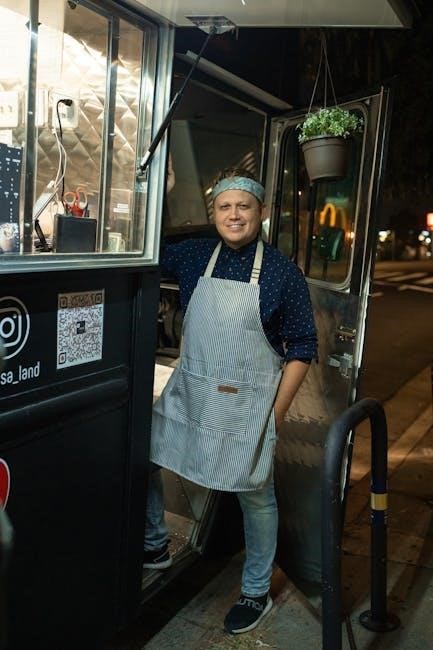A Restaurant Menu PDF is a digital document showcasing a restaurant’s offerings, designed to enhance customer experience and streamline ordering. It combines visually appealing design, clear typography, and detailed descriptions to showcase dishes effectively, while also serving as a practical tool for online ordering and menu management.
What is a Restaurant Menu PDF?
A Restaurant Menu PDF is a digital document that showcases a restaurant’s food and beverage offerings in an organized and visually appealing format. It typically includes detailed descriptions of dishes, pricing, and images, designed to entice customers and enhance their dining experience. The PDF format allows for easy sharing, whether through a website, email, or QR code, making it accessible to customers before they visit the restaurant. A well-designed menu PDF can also include interactive elements, such as clickable links to online ordering systems, making it a versatile tool for modern restaurants. It serves as both a marketing asset and a practical guide for customers to explore the menu offerings.
Importance of a Well-Designed Restaurant Menu
A well-designed restaurant menu is crucial for creating a positive customer experience and driving sales. It serves as a visual representation of the restaurant’s brand, reflecting its style and quality. A thoughtfully crafted menu can influence customer choices, guiding them toward high-margin items and enhancing overall satisfaction. Additionally, a well-organized menu helps staff efficiently manage orders and reduces errors. In the digital age, a menu PDF also plays a key role in online presence, allowing customers to preview offerings before visiting or ordering online. A professional and visually appealing menu PDF can set a restaurant apart from competitors and build a lasting impression on diners.
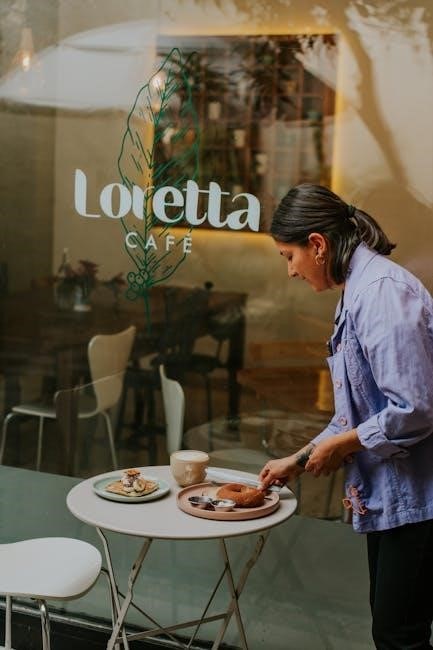
Design Principles for a Restaurant Menu PDF
Designing a restaurant menu PDF requires balance between visual appeal and functionality, ensuring clarity in layout, font choices, and descriptions while incorporating high-quality images that reflect the restaurant’s brand.
Understanding Restaurant Menu Layout and Structure
A well-structured restaurant menu PDF is essential for enhancing readability and customer experience. It typically includes sections like appetizers, main courses, and desserts, each clearly categorized. The layout should guide customers seamlessly, making it easy to find popular items. High-quality images and concise descriptions can entice diners, while pricing strategies and placement of high-margin dishes are strategically considered. Digital tools like Canva and MenuMaker.io offer customizable templates to create visually appealing and organized menus. A structured menu not only reflects the restaurant’s brand but also streamlines the ordering process, both in-person and online. Proper layout and organization can significantly influence customer satisfaction and sales;
Color Schemes and Visual Appeal in Menu Design
Color schemes and visual appeal are crucial elements in restaurant menu PDF design, as they attract customers and reflect the restaurant’s brand identity. Earthy tones like brown and green create a rustic feel, while vibrant colors can evoke energy and appetite. High-quality images of dishes enhance visual appeal, making items more enticing. Tools like Canva and MenuMaker.io offer customizable templates with pre-designed color palettes, ensuring consistency and professionalism. Seasonal adaptations, such as holiday-themed colors, can refresh the menu’s look. Balancing color and text is key to maintain readability. A visually appealing menu not only draws attention but also influences customer perceptions and preferences, making it a powerful tool for enhancing dining experiences.
Typography and Font Choices for Clarity and Style
Typography and font choices play a vital role in restaurant menu PDF design, ensuring clarity and style. Fonts should be readable at a glance, even on digital screens. Serif fonts, like Times New Roman, convey tradition, while sans-serif fonts, such as Helvetica, offer a modern look. Script fonts can add elegance but should be used sparingly to avoid clutter. Font sizes and styles should guide customers’ eyes, with larger text for headings and bold or italic for highlights. Tools like Canva and MenuMaker.io provide customizable font options to match brand identity. Consistent typography enhances professionalism, making the menu both functional and visually appealing for diners. Proper font selection ensures a seamless and enjoyable dining experience.
Using High-Quality Images in Your Menu
High-quality images in a restaurant menu PDF are essential for captivating customers and showcasing dishes attractively. Professional photos of menu items can enhance the dining experience by making dishes look appetizing and appealing. Using high-resolution images ensures clarity on digital screens, while consistent styling aligns with the restaurant’s brand. Tools like Canva and MenuMaker.io allow easy integration of images into menu designs. However, balance is key—too many images can clutter the menu. Focus on showcasing signature dishes and using images that complement the text. Properly optimized images ensure quick loading times, enhancing user experience. By combining stunning visuals with clear descriptions, restaurants can create an engaging and professional menu that drives customer interest and satisfaction.
Writing Compelling Menu Item Descriptions
Compelling menu item descriptions are crucial for enticing customers and driving sales. They should strike a balance between clarity and creativity, using sensory language to highlight flavors, textures, and aromas. Describe dishes in a way that evokes curiosity and appetite, while ensuring accuracy. Include key ingredients, preparation methods, and portion sizes to inform diners. Avoid overly complex terms to maintain accessibility. Use adjectives like “fresh,” “slow-cooked,” or “artisanal” to add appeal. Highlight dietary options or unique selling points, such as “locally sourced” or “signature dish.” Well-crafted descriptions not only guide customers but also enhance their perception of value and quality, making your menu a powerful marketing tool. Keep descriptions concise yet engaging to ensure readability and impact.
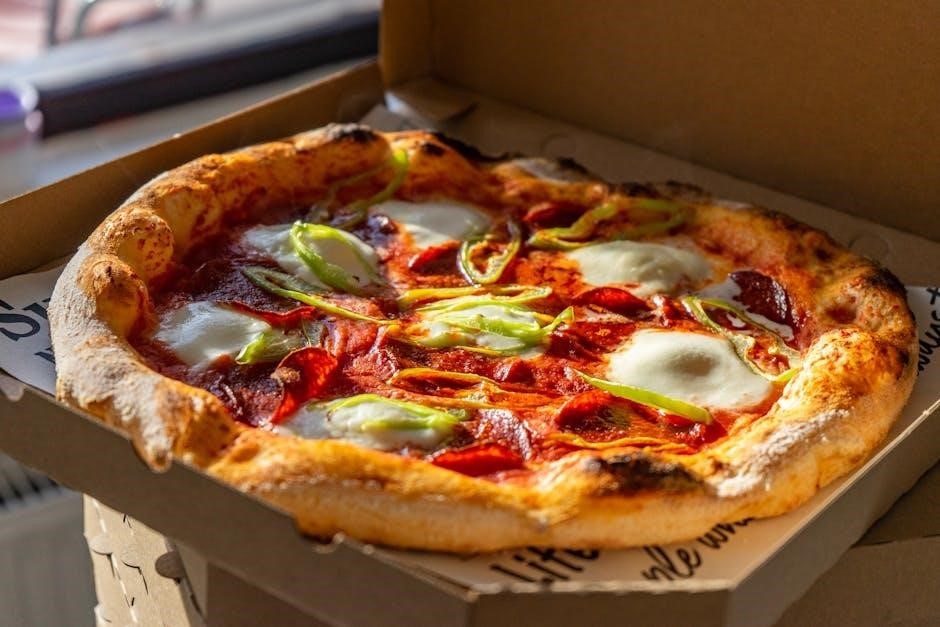
Tools and Software for Creating a Restaurant Menu PDF
Popular tools like Adobe Illustrator, Canva, and MenuMaker;io offer customizable templates and design features to create professional restaurant menus. These platforms cater to both professionals and non-designers, ensuring ease of use and high-quality results.
Adobe Illustrator for Professional Menu Design
Adobe Illustrator is a top choice for creating professional restaurant menu PDFs, offering advanced design tools and scalability. Its vector graphics ensure crisp visuals at any resolution, making it ideal for both digital and print menus. Designers can craft custom layouts, apply sophisticated color schemes, and manipulate typography with precision. Illustrator’s robust features, such as layers and effects, allow for intricate designs that elevate the menu’s visual appeal. While it requires design expertise, the results are unparalleled for high-end restaurant branding. For professionals seeking detailed control and superior quality, Adobe Illustrator remains the industry standard for menu design, ensuring a polished and visually stunning final product.
Canva: A User-Friendly Option for Restaurant Menus
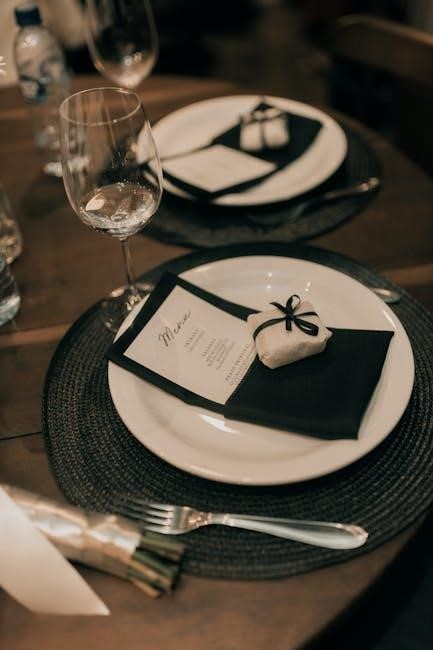
Canva is an accessible and intuitive platform for designing restaurant menu PDFs, perfect for those without advanced design skills. It offers a wide range of customizable templates tailored to various restaurant styles, from casual to fine dining. Users can easily modify fonts, colors, and images to align with their brand identity. Canva’s drag-and-drop functionality simplifies the design process, making it quick to create professional-looking menus. Additionally, its collaboration features allow teams to work together in real-time. With Canva, restaurants can efficiently produce visually appealing and cohesive menu designs without the need for expensive software or extensive design experience, ensuring consistency and style in their branding.
MenuMaker.io for Customizable Templates
MenuMaker.io is a versatile tool offering customizable templates for creating restaurant menu PDFs. It provides a variety of pre-designed layouts that cater to different culinary styles and preferences. Users can easily personalize these templates by adjusting colors, fonts, and images to match their restaurant’s branding. The platform also allows for seamless integration of high-quality images and detailed descriptions, enhancing the visual appeal of the menu. With a user-friendly interface, MenuMaker.io simplifies the design process, enabling restaurants to produce professional-looking menus efficiently. Its flexibility and customization options make it an excellent choice for establishments aiming to create a menu that reflects their unique identity and attracts customers.
Google Docs for Collaborative Menu Editing
Google Docs is an excellent tool for collaborative menu editing, allowing multiple users to contribute and edit in real-time. Its cloud-based platform ensures that changes are instantly visible to all collaborators, making it ideal for teams working remotely or in different locations. The ability to leave comments and suggestions directly within the document streamlines the feedback process, ensuring that everyone’s input is considered. Additionally, Google Docs is accessible from any device with an internet connection, offering unparalleled flexibility; While it may lack the advanced design features of specialized software, its collaboration capabilities make it a practical solution for restaurants aiming to maintain consistent and up-to-date menus efficiently.
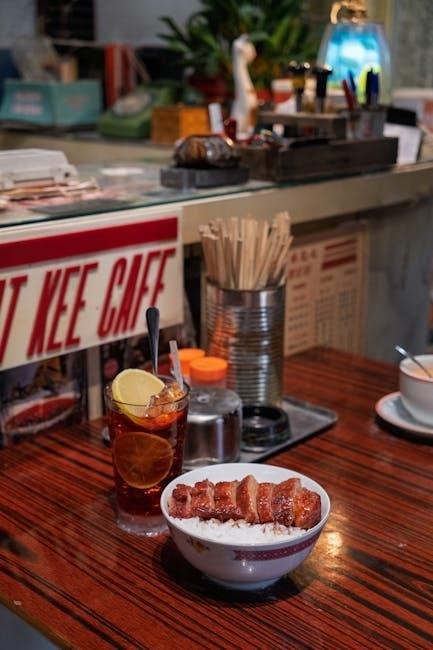
Psychological Factors in Menu Design
Psychological factors in menu design influence customer choices through color schemes, layout, and descriptive language, enhancing appeal and driving sales effectively.
How Menu Design Influences Customer Choices
Menu design significantly impacts customer decisions by guiding attention to high-profit items through strategic placement and visual emphasis. The use of high-quality images, bold typography, and appealing descriptions enhances dish attractiveness, influencing ordering behavior. Color schemes and layout structure subconsciously direct customers to specific menu sections, while pricing strategies like anchoring or bundling affect perceived value. Descriptive language evokes emotions, making dishes more enticing. The placement of items, such as featuring popular dishes in prime spots, increases their visibility and likelihood of selection. Overall, a well-designed menu aligns with customer preferences, driving satisfaction and boosting sales effectively.
Pricing Strategies and Menu Placement
Pricing strategies and strategic menu placement are crucial for influencing customer purchasing decisions. Techniques like anchoring, where high-priced items make others seem more affordable, and psychological pricing, such as ending prices with .99, encourage spending. Placing high-margin items in prominent locations, such as the top or center of the menu, increases their visibility and likelihood of being ordered. Additionally, bundling items or offering combos can enhance perceived value. Digital menus, including PDF formats, allow for dynamic pricing adjustments and real-time updates, ensuring flexibility and maximizing profitability. Strategic placement and pricing not only drive sales but also enhance the customer experience by guiding them toward popular or profitable options seamlessly.
Using Menu Psychology to Increase Sales
Menu psychology plays a vital role in driving sales by influencing customer decisions subtly. Techniques like emotional descriptions, high-quality images, and strategic item placement can elevate appetite and spending. Restaurants often use anchoring by placing premium items first, making other options seem more affordable. Color schemes and typography also play a role, with warm colors stimulating hunger and bold fonts highlighting popular dishes. Additionally, removing dollar signs and using mouthwatering adjectives can reduce price sensitivity and increase perceived value. By understanding customer behavior and leveraging these psychological strategies, restaurants can create menus that not only attract attention but also encourage profitable purchases, enhancing overall customer satisfaction and loyalty.
Menu engineering optimizes profitability by analyzing item popularity and margins, enabling strategic placement and pricing to maximize sales and revenue while maintaining customer satisfaction and menu appeal. Analyzing menu items for profitability involves evaluating each dish’s contribution to overall revenue; By assessing popularity, cost, and profit margins, restaurants can identify high-margin items to highlight and low-performing dishes to adjust or remove. This process ensures that the menu remains balanced, appealing, and financially sustainable. Tools like MenuMaker.io and Canva can aid in designing menus that visually emphasize profitable items. Regular analysis helps restaurants stay competitive, optimize pricing, and enhance customer satisfaction by ensuring the menu reflects both profitability and demand. This strategic approach is essential for long-term success in the competitive food service industry. A balanced menu offer ensures variety and diversity in dishes, catering to different tastes and dietary preferences. It involves organizing items to highlight popular choices while supporting less popular yet unique offerings. Tools like Canva and MenuMaker.io can help design menus that visually appeal and maintain clarity. A balanced menu also considers pricing strategies, ensuring a mix of high-margin and affordable options. Seasonal adaptations and special items can enhance variety without overwhelming customers. This approach helps restaurants attract a broader audience, ensuring satisfaction and encouraging repeat visits. A well-rounded menu is key to maintaining customer interest and driving long-term success. Seasonal and holiday menu adaptations allow restaurants to refresh offerings, aligning with current trends and celebrations. This approach keeps menus dynamic and relevant, attracting customers with special dishes tailored to specific times of the year. Tools like MenuMaker.io enable easy customization of PDF menus, ensuring designs match seasonal themes. For example, summer specials or holiday-themed items can be highlighted to create excitement. Digital tools also facilitate quick updates, making it easier to adapt menus without redesigning from scratch. By incorporating seasonal and holiday elements, restaurants can enhance customer experience and drive engagement, ensuring their menu remains fresh and appealing year-round. Digital integration transforms restaurant menus into interactive experiences, using QR codes, online ordering, and PDFs to enhance accessibility and customer engagement, aligning with modern dining trends and efficiency. QR code menus represent a cutting-edge solution for restaurants, enabling customers to access menus via smartphones instantly. By scanning a QR code, diners can view digital menus, reducing the need for physical copies and streamlining the ordering process. This approach not only enhances hygiene but also allows for real-time menu updates, seasonal adjustments, and personalized promotions. QR codes can link to interactive PDFs, ensuring a seamless and engaging dining experience. Restaurants can also track customer interactions, providing valuable insights for menu optimization. This modern method aligns with the growing preference for digital convenience, making it a practical and innovative tool for contemporary dining establishments. Online ordering and digital menu integration have revolutionized how restaurants connect with customers. By linking their menu PDFs to online platforms, restaurants can offer a seamless dining experience, allowing customers to browse, order, and pay digitally. This integration reduces wait times, minimizes errors, and enhances convenience. Digital menus can be easily updated to reflect seasonal changes, specials, or inventory adjustments, ensuring customers always access the most current offerings. Additionally, restaurants can incorporate high-quality images, detailed descriptions, and interactive elements to make the menu more engaging. This approach not only streamlines operations but also provides valuable customer data, enabling restaurants to optimize their offerings and improve overall satisfaction. Interactive PDF menus offer a dynamic way to engage customers, providing a seamless and immersive dining experience. By incorporating clickable links, high-quality images, and videos, restaurants can showcase their offerings in a visually appealing and user-friendly format. Customers can easily navigate through categories, view dish details, and even place orders directly from the menu. This interactivity enhances convenience and satisfaction, while also allowing restaurants to update their menus in real time. Additionally, interactive PDFs can include features like search functionality and dietary filters, making it easier for customers to find what they’re looking for. This modern approach not only elevates the dining experience but also streamlines operations for restaurants. Use high-quality images, clear typography, and logical organization to create an appealing menu. Regularly update offerings and ensure consistency across digital platforms for a cohesive customer experience. Regularly updating your menu ensures it reflects seasonal ingredients, customer preferences, and market trends. This keeps offerings fresh and exciting, attracting repeat customers. Use tools like MenuMaker.io or Canva to easily modify designs and descriptions. Update pricing to maintain profitability and adapt to supply chain changes; Incorporate customer feedback to refine dishes and improve satisfaction. Seasonal menus can highlight special items, creating a sense of urgency. Digital menus, such as QR code or interactive PDFs, allow real-time updates without reprinting. Consistency across online and physical menus is crucial for a seamless customer experience. Regular audits ensure accuracy and relevance, keeping your menu aligned with your restaurant’s brand and vision. Consistency across platforms is crucial for maintaining a cohesive brand image and providing a seamless customer experience. Whether your menu is displayed as a PDF, on a website, or via a QR code, it must look and read the same. Use design tools like Canva or MenuMaker.io to create uniform layouts, fonts, and color schemes. Regularly update all versions simultaneously to avoid discrepancies. Ensure pricing, descriptions, and item availability align across digital and physical formats. Collaborative tools like Google Docs can help teams maintain consistency during edits. Conduct regular audits to verify alignment and make adjustments as needed. This ensures customers receive a consistent and reliable representation of your menu, enhancing trust and satisfaction. Customer feedback is a valuable resource for refining and enhancing your restaurant menu. By incorporating feedback, you can identify popular items, address weaknesses, and tailor offerings to customer preferences. Digital menus and QR codes provide an easy way to collect real-time feedback, allowing for immediate insights. Analyze comments to detect trends, such as underperforming dishes or recurring suggestions. Use this data to adjust descriptions, pricing, or item placement; For example, if a dish is frequently praised, highlight it visually or with special formatting. Conversely, remove or revise items that receive negative feedback. Regularly updating your menu PDF ensures it remains relevant and appealing. This iterative process fosters customer satisfaction and loyalty, ultimately driving business success.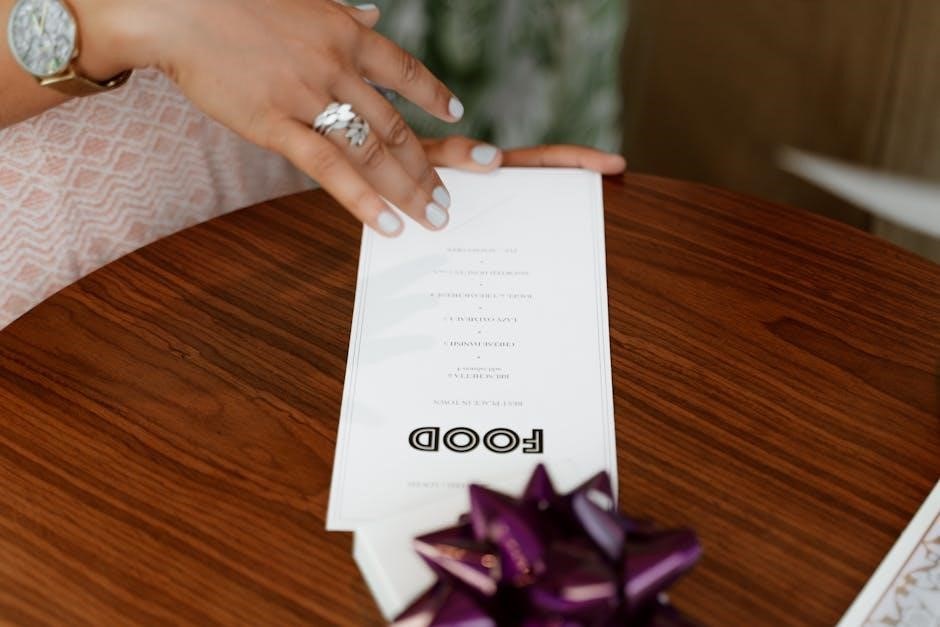
Menu Engineering for Profitability
Analyzing Menu Items for Profitability
Creating a Balanced Menu Offer

Seasonal and Holiday Menu Adaptations

Digital Integration of Restaurant Menus
QR Code Menus: A Modern Approach
Online Ordering and Digital Menu Integration
Interactive PDF Menus for Enhanced Customer Experience
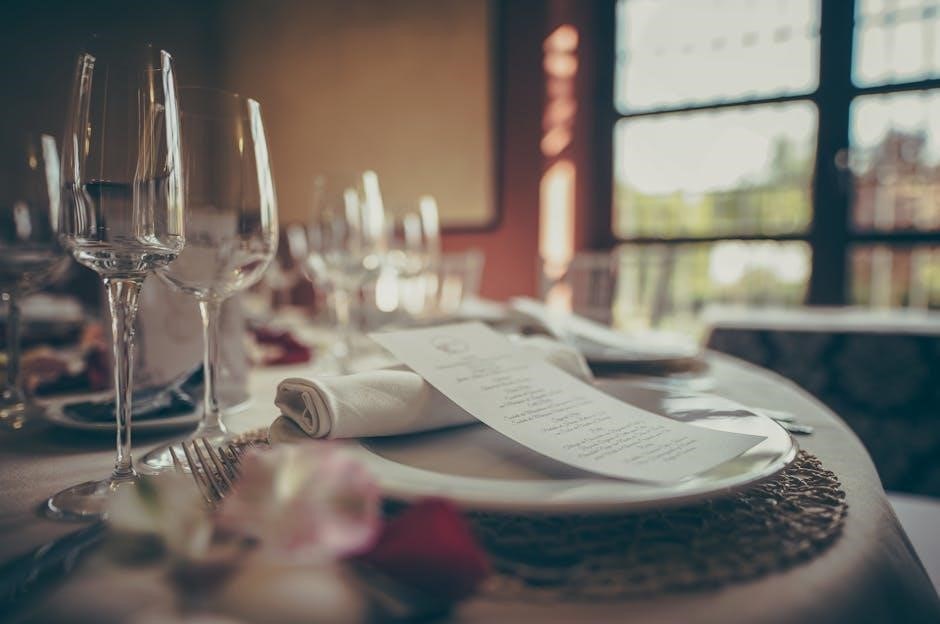

Best Practices for Restaurant Menu Design
Keeping Your Menu Updated and Relevant
Ensuring Menu Consistency Across Platforms
Customer Feedback and Menu Optimization
